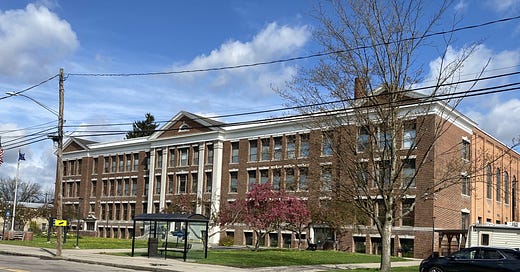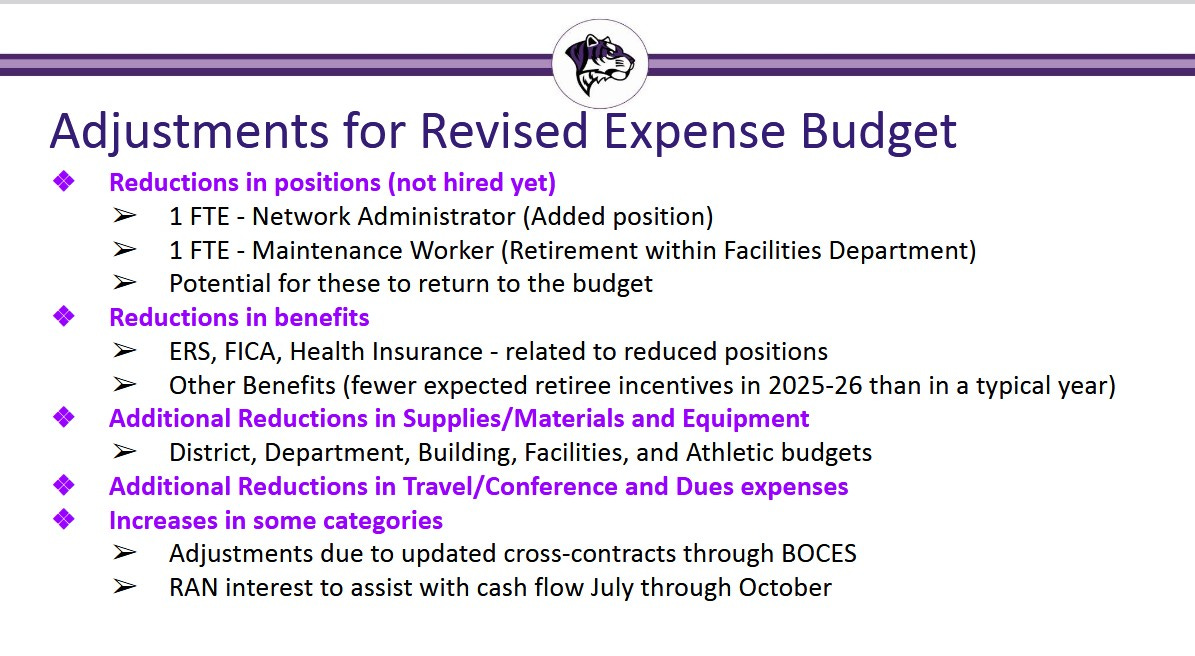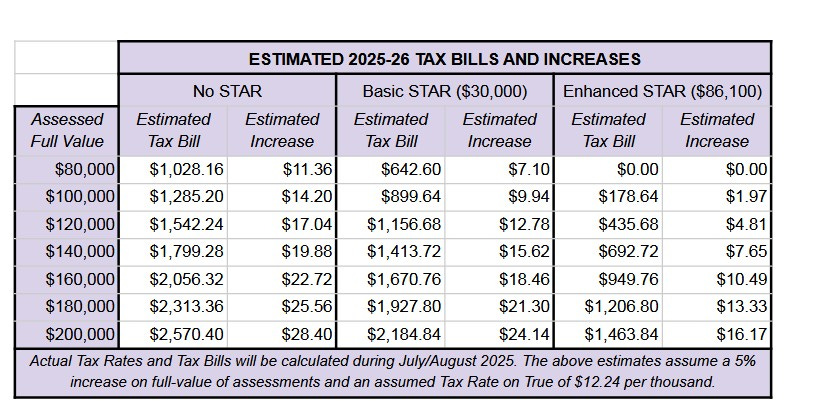Cortland School District Budget Re-vote
After the Cortland School District budget failed to achieve the 60% approval needed to pass, the district revised the proposed budget. The revised budget goes back to the voters on Tuesday, June 17.
The original budget had a tax levy increase of 4.99% (you can read my previous post assessing the original budget proposal here). The revised budget keeps the tax levy increase within the tax levy limit at 2.39%. The overall budget difference is only $379,449. In a $61 million budget, it’s not that much less. However, it will still result in less staff and cuts to supplies, materials and equipment in the district.
Most households in Cortland have an income of less than $500,00 and are therefore eligible for Basic STAR. In 2025, the median home value in Cortland was $193,000. For an average property owner, you’ll save about $94 from the original budget — but pay about $22 more than you’re paying now.
The full presentation from the district on the revised budget can be found here, or you can watch a video from the district.
Voting will take place Tuesday, June 17 from 11 am to 8 pm at the Kaufman Center in Cortland, the Cortlandville Municipal Garage, and the Virgil Town Hall.
Increasing Costs for the Code Blue Warming Center
At the Health and Human Services Committee, the County Legislators advanced a resolution to increase the budget for Code Blue Warming Center for the 2025-2026 season. New York State mandates that counties “provide shelter during inclement weather when air temperatures are at or below 32 degrees.” The Salvation Army has provided the overnight Code Blue warming center in Cortland County in the past, and is contracted to do so again for 2025-2026 season. (The County Office Building is the default daytime code blue warming space.)
In order to provide safety for the Salvation Army staff, volunteers, and all visitors to the center, the Salvation Army wants to hire an unarmed, plain clothes security officer. In the past, the warming center staff have dealt with overdoses, suicide attempts, verbal and physical assaults, and theft. The contracted cost with the security firm for the season would be $139,000.
In addition, the Salvation Army has been instructed by their headquarters that they cannot be open as a code blue warming center when children or families are in the building for programming or worship. This would impact two evenings a week and Sunday mornings for a total of 12 hours/week. While the Salvation Army staff would be available, the county would need to locate additional space and contract for use of that space, and they’ve budgeted up to $25,000 for the space.
The Salvation Army is providing a critical service to the community, and everyone’s safety is important. It also seems that no other non-profit or county agency has the interest — or staff, space, and resources — to run the overnight and weekend code blue center.
The total cost to run the warming center from October 1, 2025 to April 30, 2026 would be $543,700, and the county anticipates receiving from NYS the same allocation as last year, $323,648. This leaves a gap of over $220,000 for the county.
Allocations from New York State are made “according to a methodology developed by the Office of Temporary and Disability Assistance (OTDA) and approved by the Division of Budget” (memo). That methodology does not seem to be clear to the Social Services Commissioners since Commissioner Kristen Monroe pointed out the huge disparities in funding allocations to counties. Our neighboring county, Tompkins, receives $2 million, the most of any county in the state and more than 5 times the allocation to Cortland County.
While our state representatives, Sen. Lea Webb and Assemblymember Anna Kelles, vote on the overall NYS budget, they do not create the methodology OTDA uses to decide allocations. They can, however, question the OTDA Commissioner on the methodology used and advocate for changes that may benefit Cortland County in the future.
The discussion at the committee meeting focused exclusively on the overnight warming center at the Salvation Army. Next week, though, Matt Whitman, Director of the Rural Health Institute and Chair of the Cortland County Housing and Homelessness Coalition, will provide an update on Grace Space. The presentation will be on Thurs. June 19 from noon to 1 pm at Cortland United Presbyterian Church (25 Church St, Cortland). Grace Space served as the daytime space for the unhoused population during the 2024-2025 season in Grace and Holy Spirit Church (13 Court St.) and was funded from private sources.
Taking a Stand Against the “Big, Beautiful” Budget Cuts
The County Health and Human Services Committee also advanced a resolution “Calling on Congress to Reject the Harmful Medicaid and Nutrition Assistance Cuts Included in the Final Budget Reconciliation Bill.” The resolution will move to the full County Legislature on June 26 for consideration. This is the first time the county has taken a public stand on the federal cuts that have, or will, hurt the residents of Cortland County, and I applaud them for doing so.
In a county that Trump won (Trump 11,699 votes to Harris 10,230 votes), the provisions in the One Big Beautiful Bill Act will dramatically impact Cortland residents, the County, healthcare providers and hospitals.
Legislator and Minority Leader Beau Harbin shared the numbers of Cortland residents who may be impacted. As of February 2025, 5,696 Cortland County residents receive SNAP benefits, totaling over $1 million in benefits, and 12,172 residents were enrolled in Medicaid (30-33% of county residents). While not all enrolled may lose benefits, those are still significant populations.
In addition to the direct impact to individuals, rural hospitals will be impacted by the lose of Medicaid funds, risking closure and the potential for healthcare deserts. KFF Health News reports that the bill will “batter” rural hospital finances, and Guthrie staff say the bill is “risking patient lives.”
The full resolution, based on language from the New York Association of Counties (NYSAC) reads:
WHEREAS, the recently passed House Budget, H.R.1, dramatically cuts federal funding for Medicaid, the Affordable Care Act, and supplemental nutrition assistance (SNAP) in New York State; AND
WHEREAS, these cuts amount to over $15 billion dollars annually to New York State, which would devastate county governments, healthcare providers, hospitals, food assistance recipients, and vulnerable residents throughout the State; AND
WHEREAS, these cuts include over $7.5 billion annually to New York’s Essential Plan and $2.5 billion to Medicaid, and the elimination of $3.1 billion in federal funding allocated for New York State Medicaid; AND
WHEREAS, the budget would add $3.3 billion in Medicaid costs to New York taxpayers, and $1.3 billion in added uncompensated care costs to hospitals; AND
WHEREAS, over 1 million Medicaid enrollees, representing 15% of the entire program, would lose health insurance, and administrative costs would rise by over 20% due to new program requirements, and healthcare providers would close because of the cost increases; AND
WHEREAS, nutrition program (SNAP) cuts would represent an additional $2.1 billion in state impact beyond Medicaid cuts; AND
WHEREAS, the SNAP program changes would change the funding ratio from 50/50 federal/state-county to 25/75 federal/state-county cost share, and new program requirements would create significant new administrative costs for counties; AND
WHEREAS, county governments will be forced to choose between raising property taxes and cutting vital services to fill the resulting budget shortfalls; AND
WHEREAS, the proposed federal cost-shifting will lead to the closure of hospitals, community health centers, and the elimination of healthcare jobs, creating healthcare deserts, particularly in rural counties, and destabilizing local economies; AND
WHEREAS, county Departments of Social Services are already operating with limited staff and resources, and the increased administrative demands resulting from the proposed eligibility and work requirements would be unmanageable without significant new investments; AND
WHEREAS, the 57 counties of New York State and New York City do not have the capacity to assume any more cost shifts, which would certainly place a significant financial burden on already overtaxed New Yorkers; AND
WHEREAS, the bill now heads to the U.S. Senate to be amended and returned to the House of Representatives for final passage; NOW THEREFORE BE IT
RESOLVED, the Cortland County Legislature hereby calls upon the New York Congressional Delegation in the U.S House and Senate to reject these spending cuts that disproportionately target New York State, and would decimate the state’s county budget
Final Thoughts
Whether we’re funding schools and services for special education, providing temporary shelter for the unhoused, feeding the hunger, or providing health care for the most vulnerable, investing in people can be expensive.
Every budget, whether your household budget or the federal budget, is a reflection of values. We spend money on the things we care about. And people matter.
A community of unsheltered, ill, hungry and struggling residents is not a community at all.




